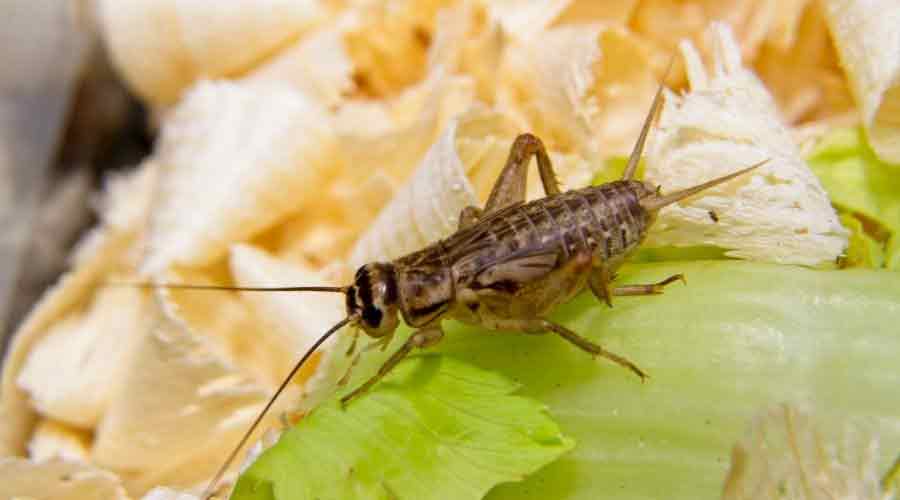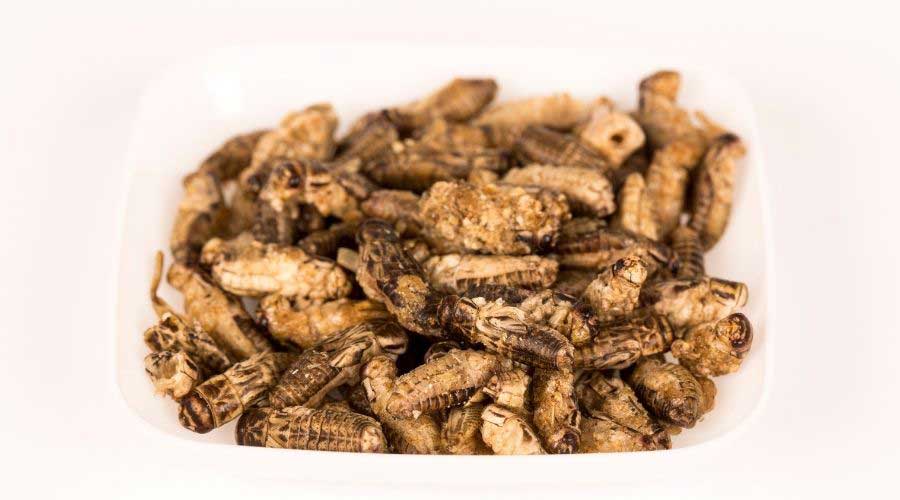Sometimes your bearded dragon cannot finish the crickets you place in their cage. A bearded dragon owner may leave the uneaten crickets in the pet’s tank without realizing the consequences of their actions.
You should remove uneaten crickets in your bearded dragon’s cage. Live uneaten crickets will nibble on your pet, spread pathogens, and interrupt them during their sleep and also leave an unpleasant odor in your beardie’s cage.
As a dragon keeper, you should always ensure that your beardie has a goodnight’s sleep and is safe from insect attacks. This article looks at everything you need to know about feeding crickets to your bearded dragon.
What are Some of the Hazards of Leaving Crickets in a Bearded Dragons Cage?
Even though crickets offer bearded dragons lots of nutrients, they can be harmful if they are left with bearded dragons. Here are some of the dangers that they can cause.
Cricket Bites
Crickets are tiny and are pretty fast. When they reach the point of starvation, they will go to any extent to have their bellies filled. They often nip at the bearded dragon’s eyelids, toes, and the tip of the tail.
Although the bearded dragon has rough skin, a cricket’s bite hurts badly. Crickets can wound your bearded dragon and bring about infections if left untreated. The nocturnal brown crickets and diurnal black insects are the most common types of crickets sold, and they have a terrible bite.
Choking
When feeding your bearded dragon crickets, it’s always advisable to give them small pieces to avoid choking. Your pet will pursue movement, and if it spots a cricket, it will feed on it regardless of its size. Giant crickets can lead to choking.
Choking beardies will produce sounds like gagging or coughing, but you may not hear any sound if you aren’t supervising. When your pet eats, you should always be present and remove the excess crickets.
If your pet chokes, clear their throat or take it to the vet.
Parasites and Pathogen
Crickets can carry pathogens and parasites, especially wild crickets. However, farm-raised crickets and those sold in the stores are unlikely to have parasites or pathogens.
If the crickets are sprayed with pesticide, your bearded dragon may ingest the toxin on the pesticide.
Even if your pet ingests the pesticides in small quantities, the toxins can cause serious damage since pesticides are poisonous. In severe cases, the toxins can kill your pet.
Infection
While moving around the cage, crickets may step on decaying food matter, fecal pellets of urates with bacteria. If your bearded dragon has bite wounds, it may be affected by the bacteria that coats the cricket. The infection, if left unattended, can cause death.
Impaction
You should always follow the general principle of feeding a pet, providing them small pieces of their food. When it comes to a bearded dragon, you should follow the rule and feed them crickets smaller than the width of their eyes.
If you leave them in your pet’s cage, you won’t be able to follow this rule, and your pet will feed on any size of crickets they come across.
Smaller crickets are more manageable for your pet to digest, whereas large crickets can cause blockage on your bearded dragon gut tract, which can cause impaction. Impaction can be fatal if it’s not treated.
Stress
If crickets are creeping and crawling over a bearded dragon’s body, the beardies will become upset. Your pet’s stress levels will go up, and they may decide not to eat crickets anymore. A sign of stress is a black beard, among others.
To avoid this, ensure that you don’t leave crickets in your pet’s cage.
How Long Should I Leave Crickets in My Bearded Dragon’s Cage?
You should only leave crickets in your bearded dragon’s cage for 5-10 minutes when they are baby dragons. You can increase the feeding time for an adult dragon to 10 -15 minutes, primarily if you feed them daily.
This time will give your bearded dragon plenty of time to hunt and eat all the crickets. However, you shouldn’t force them to eat the crickets, mainly if you’re using tongs or hand-feeding them.
It’s crucial to observe your dragon when feeding to avoid choking or hiding a cricket.
You can use a plastic tub for cricket feeding, and you will always know when your pet is finished; the crickets won’t get an opportunity to escape or even hide in the cage.
How To Feed Crickets To My Bearded Baby Dragon?
Baby bearded dragons have no hunting skill, and it’s easier for you to hand feed them instead of giving them crickets to chase.
You can hand-feed your bearded baby dragon by hand or using tongs. Use feeding tongs with a rubberized tip to minimize any chance of your bearded dragon getting an injury.
Place one or two crickets in the cage if you want your dragon to hunt. Your baby dragon will chase and catch the crickets without being overwhelmed by many crickets. Since they are small, the best crickets to feed your baby dragon are the pinhead crickets.
How To Feed Crickets To My Juvenile Baby Dragon?
Juvenile bearded dragons have enough hunting skills to catch some crickets, even though you can still hand feed them. They can feed on a feeding bowl, although crickets’ feeding bowl is ineffective since the crickets can escape easily.
Juvenile bearded dragons can feed on giant crickets such as young banded crickets and Jamaican or European field crickets.

How To Feed Crickets To My Adult Bearded Dragon?
Adult bearded dragons are good at hunting. They also have fewer feeding sessions in a day so that you can offer them more crickets at once during feeding sessions.
You can hand-feed your pet if you want to as a way to bond with your pet. However, adult bearded dragons enjoy hunting, so you should reduce hand feeding and let them perfect their hunting skills.
Crickets have low-fat content and are a good source of protein, so you will need to regulate your bearded dragon’s diet.
How Many Crickets do I feed my Baby Bearded Dragon?
A bearded dragon is considered a baby from birth to three months. Like any other baby, a bearded baby dragon will need to be fed regularly throughout the day for faster growth. You should feed baby dragons 20 to 40 small crickets five times every day.
It would be best if you cared for them to ensure that they get the right food for their size; the crickets shouldn’t be larger than the distance between your pet’s eyes. A feeding session should last 5-10 minutes, and you should remove the excess crickets.
As the bearded dragons continue to grow, they will require fewer crickets and more vegetables.
How Many Crickets Should I Feed My Juvenile Bearded Dragon?
A bearded dragon is a juvenile from three months to 18 months. They are still growing from 3 months to 8 months, and you need to continue feeding them crickets; however, you should feed them three times a day.
Nine months to 18 months, your bearded dragon is in its teenage stage, and you should drop cricket feeding two times a day. Mostly at 14 weeks, you introduce more vegetables into the dragon’s diet.
A juvenile bearded dragon should be fed 25 to 60 crickets 2 to 3 times a day for 5 to 20 minutes.
How Many Crickets Should I Feed My Adult Bearded Dragon?
From 18 months onward, your bearded dragon will mainly feed on vegetables more than insects, and an adult bearded dragon consumes 80% of vegetables and 20% of insects. As a bearded dragon owner, you should give your pet 10 to 20 crickets per day.
You should feed your bearded dragon in one session that lasts 10 to 15 minutes.
Some factors determine what, when and how long you should let your pet feed on crickets, and the elements are :
- Age of your bearded dragon.
- Your bearded dragon’s health.
- If your bearded dragon is gravid or not.
- The source of your live crickets.
- If your bearded dragon is consuming vegetables or other insects like Dubia roaches.
How Many Crickets Should I Put in My Bearded Dragon’s Cage at One Time?

First, you should keep track of the number of crickets you feed your beardie. The best way to do this is to give small numbers of crickets at a time to your bearded dragon. If you want to add more, ensure that your pet has hunted down and eaten all the previous ones.
Adding 2-3 crickets at a time to your bearded dragon’s cage will allow you to track how many crickets they have eaten and how many they have not eaten. If you add too many crickets, they can escape and hide, which you should avoid.
Feeding a large number of crickets for your pet in a separate tank with no places for the crickets to hide is a good option. If your bearded dragon can hunt 2 to 3 crickets quickly, you can increase the number of crickets you add at a time.
How To Get Crickets Out Of My Bearded Dragon Cage
If you feed your bearded dragon crickets and there are leftovers, how do you remove them from the cage? You can use the following methods to remove the leftover crickets from your pet’s cage.
Catch Them One by One
It’s a time-consuming way for catching uneaten crickets, but it’s the best way since you will see all the uneaten crickets. To capture the crickets, you can use your hands or a piece of toilet paper.
Use a Black Box
You can use a black box that your pet cannot get into by placing cricket food in it. Leave the black box in an open space and lure the crickets into the box; you can use the box to return the crickets into their holding place.
Using a Plastic Cup
You can lure the crickets using their food and catch each cricket with an overturned plastic cup. Cover the cup with paper to prevent the crickets from jumping out of it while transporting them to their holding place.
Tips When Feeding Crickets To Bearded Dragons

In case you are finding it hard to catch uneaten crickets out of your bearded dragon’s cage, here are some tips you can use so that you can reduce the time you waste catching them.
Feed One At a Time
You can feed your pet one cricket at a time, and once it has had enough, you can return the remaining crickets to their holding place.
Feed-in a Separate Container
If you have a spare plastic container, you can feed your bearded dragon from there. Using a separate container removes the risk of any crickets being in the cage. When your pet has had enough, you can return the remaining crickets to their holding place.
Refrigerate the Crickets
Putting the crickets in the fridge for a few minutes before feeding them to your pet will slow the crickets down. Your bearded dragon will have an easier time catching the crickets and reducing any bites or stress risks.
FAQ’s about bearded dragons?
Conclusion
It would be best if you never left any crickets in your bearded dragon’s cage to avoid your pet having stress, bites, and infections. Ensure that you remove them from your pet’s cage if there are leftover crickets. Removing crickets from your pet’s cage will enable your dragon to enjoy a goodnight’s sleep.
More is to come, so sign up to continue receiving important updates about bearded dragons.





Leave a Reply